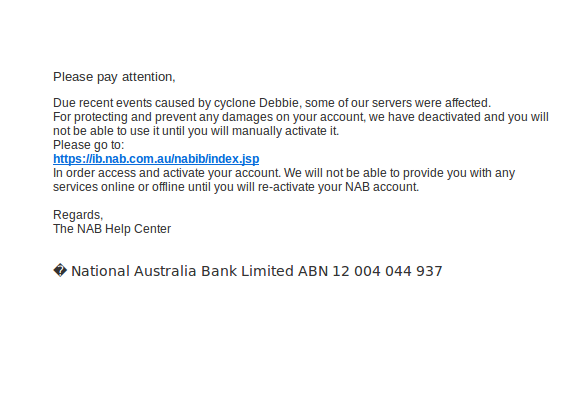One week on from the tragedy of Cyclone Debbie Hitting the North East Coast state of Queensland in Australia, victims are being targeted by another tragedy. Last night security researcher Adam Bennett from the Red Piranha threat Intelligence team picked up a phishing campaign targeted at the already tired and battered people caught up in this natural disaster. Cyclone Debbie's 163km/h winds and more than 240mm of rain has effected nearly half the East Coast of Australia and caused multiple fatalities. Queensland Premier Annastacia Palaszcuk said the damage bill for Cyclone Debbie's trail of destruction in Queensland was expected to be in the billions.
The unsophisticated phishing campaign is a NAB (National Australia Bank) account reactivation letter sent via email. The email contains a link “https://ib.nab.com.au/nabib/index.jsp“ that looks like a real National Australia Bank domain but the link “http://lararachel.com/ib.nabcom.au/” will actually direct the target to another site hosting a fake NAB login page.

Once the target has entered the credentials into the fake page the actors would then have access to the victims real account details.The Indicators of compromise have been reported to our friends via the Open threat exchange and we warn our clients not to click on links or open attachments from unsolicited emails at any time.

Phishing is the attempt to obtain sensitive information such as usernames, passwords, and credit card details (and, indirectly, money), often for malicious reasons, by disguising as a trustworthy entity in an electronic communication.[1][2] The word is a neologism created as a homophone of fishing due to the similarity of using a bait in an attempt to catch a victim. According to the 3rd Microsoft Computing Safer Index Report released in February 2014, the annual worldwide impact of phishing could be as high as $5 billion.[3]
Employees today prefer accessing office data and emails on the move. To avoid mishaps it's time to take Cybersecurity Awareness Training today.
